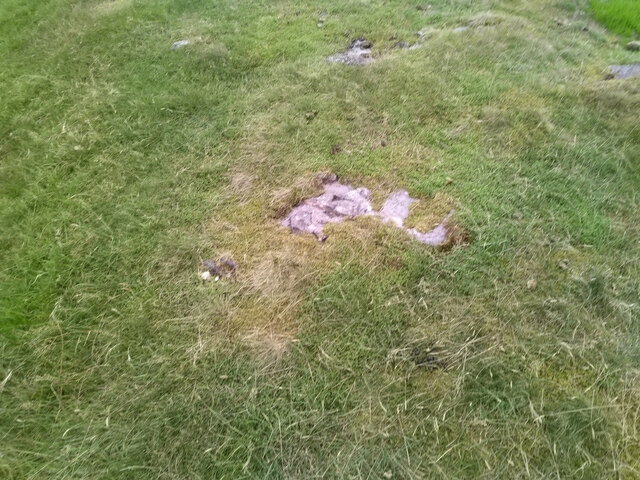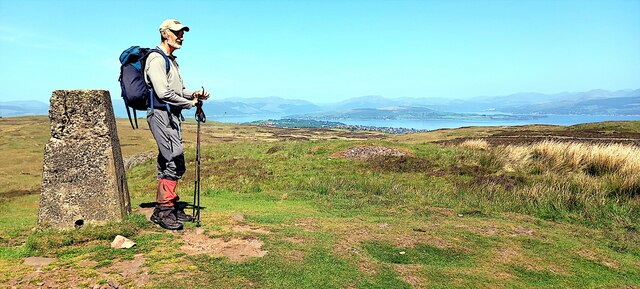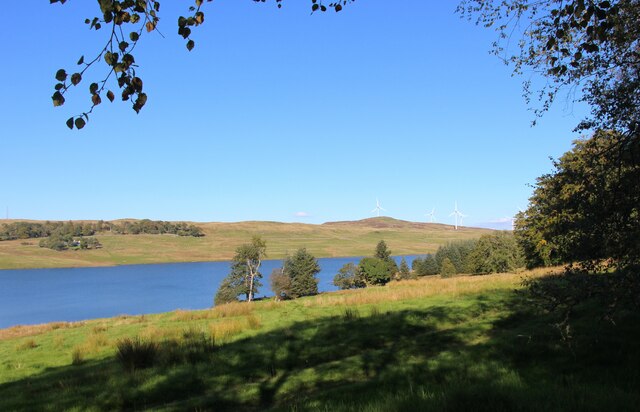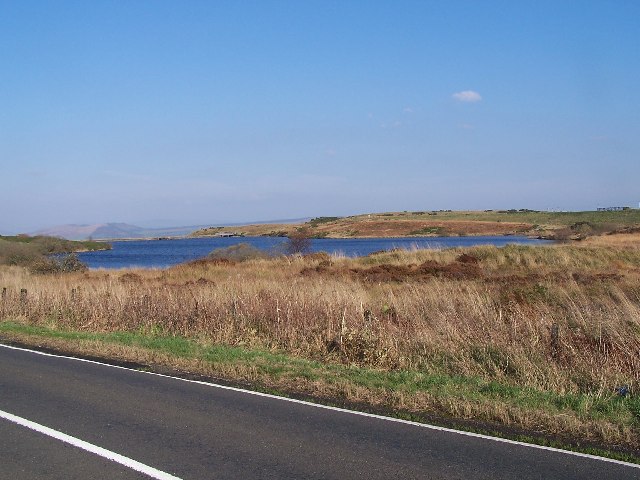Corlick Hill
Hill, Mountain in Renfrewshire
Scotland
Corlick Hill

Corlick Hill is a prominent hill located in Renfrewshire, Scotland. Situated approximately 20 miles southwest of Glasgow, it is part of the Clyde Muirshiel Regional Park and offers stunning views of the surrounding countryside.
Standing at a height of 468 meters (1,535 feet), Corlick Hill is not technically classified as a mountain, but rather a hill. However, its impressive elevation and commanding position make it a popular destination for hikers and nature enthusiasts.
The hill is characterized by its steep slopes, which are covered in heather and grasses, creating a picturesque landscape. The summit of Corlick Hill is relatively flat, providing ample space for visitors to pause and take in the panoramic vistas that stretch as far as the Isle of Arran and the Ayrshire coast.
Access to Corlick Hill is relatively straightforward, with a well-marked path leading to the summit from the nearby village of Lochwinnoch. The climb is moderately challenging, but the rewards are well worth the effort.
Aside from its natural beauty, Corlick Hill is also of historical significance. The hill is home to the remains of an Iron Age fort, known as Knockoura, which dates back over 2,000 years. The fort's defensive walls and ditches can still be seen today, providing a glimpse into the area's ancient past.
Overall, Corlick Hill offers a fantastic opportunity to explore the Scottish countryside, appreciate breathtaking views, and delve into the region's rich history. Whether you're an avid hiker or simply seeking a peaceful retreat, Corlick Hill is a must-visit destination in Renfrewshire.
If you have any feedback on the listing, please let us know in the comments section below.
Corlick Hill Images
Images are sourced within 2km of 55.918286/-4.7371575 or Grid Reference NS2972. Thanks to Geograph Open Source API. All images are credited.
![Remains of enclosures See <a href="https://www.geograph.org.uk/photo/1853572">NS2973 : Lurg Moor Roman fortlet</a> for a discussion of various other antiquities located nearby on the moor, with links to photographs. Compared to some of those sites, the remains shown in the present photograph are less conspicuous, but they are shown on the 1:25000 OS map.
Several enclosures have been reported in the immediate vicinity of this one, but the remains shown in this photograph are the easiest to pick out visually. See <span class="nowrap"><a title="https://canmore.org.uk/site/41340/burnhead-moor" rel="nofollow ugc noopener" href="https://canmore.org.uk/site/41340/burnhead-moor">Link</a><img style="margin-left:2px;" alt="External link" title="External link - shift click to open in new window" src="https://s1.geograph.org.uk/img/external.png" width="10" height="10"/></span> (at Canmore) for further details; the subject of this photograph is structure &quot;A&quot; in that report, the D-shaped enclosure. Structures &quot;A&quot; and &quot;B&quot; together make up the enclosures that are depicted on the 1:25000 map.
[See <span class="nowrap"><a title="https://www.google.com/maps/d/viewer?mid=1Np6emNB53CxbNJmyJ_LicpxJvus&amp;ll=55.915499%2C-4.72162400000002&amp;z=19" rel="nofollow ugc noopener" href="https://www.google.com/maps/d/viewer?mid=1Np6emNB53CxbNJmyJ_LicpxJvus&amp;ll=55.915499%2C-4.72162400000002&amp;z=19">Link</a><img style="margin-left:2px;" alt="External link" title="External link - shift click to open in new window" src="https://s1.geograph.org.uk/img/external.png" width="10" height="10"/></span> for an annotated satellite image (zoom out for other antiquities located nearby). The satellite view shows some other interesting details nearby: for example, only 60 metres ESE is another feature, the form of two overlapping circles: I examined that area on a later visit: <a href="https://www.geograph.org.uk/photo/2089851">NS3072 : Possible hut circles on Burnhead Moor</a>.]
The present photograph shows two ridges, both greener than the surrounding moor, but with some dark tussocks along their course. The nearer one is straight, and the more distant one is curved into a C-shape, with the open side toward the photographer, so that they are arranged (very roughly) as &quot;C|&quot;.
In the foreground, just below the centre of the photograph, part of the nearer (straight) ridge runs across the width of the image, sloping upwards to the right. Behind it is the other (curved) ridge. Only one half of its C-shape is seen in this view; the near end of that arm of the ridge is to the left of and slightly above the centre of the photograph. From there, the ridge can be followed to the right-hand edge of the picture.
Providing confirmation of the view direction, Corlic Hill (called Corlick Hill on the OS map) appears centrally on the skyline.](https://s3.geograph.org.uk/geophotos/01/85/55/1855511_63674562.jpg)






![Sluice gate on the Devol Burn This photograph shows one of a pair of sluice gates located on the course of the Devol Burn. Just beyond the left-hand side of the sluice, another part of the burn can be seen joining this one from the right. The other sluice gate is located further up that part of the burn; compare <a href="https://www.geograph.org.uk/photo/2089519">NS3073 : Sluice gate on the Devol Burn</a>.
The foreground section of the burn had itself been diverted here by a wall that is located just 60m to the NNW, and which is shown in <a href="https://www.geograph.org.uk/photo/2089523">NS3073 : Old water valve beside the Devol Burn</a>.
See <a href="https://www.geograph.org.uk/photo/2089231">NS3073 : Auchmountain Road</a> for a view along the section of road that can be seen in the background.
[The first-edition OS map (c.1860) refers to the burn by its present name, Devol Burn, but earlier maps show some variation in the name. For example, John Ainslie&#039;s 1796 map shows the lower part of its course, the present-day <a href="https://www.geograph.org.uk/photo/1661703">NS3074 : Devol Glen</a>, as &quot;Divels Glen&quot;, while Roy&#039;s Military Survey of Scotland (1740s-50s) shows &quot;Devils Glen&quot;.]](https://s1.geograph.org.uk/geophotos/02/08/95/2089517_21f8d831.jpg)
Corlick Hill is located at Grid Ref: NS2972 (Lat: 55.918286, Lng: -4.7371575)
Unitary Authority: Inverclyde
Police Authority: Renfrewshire and Inverclyde
What 3 Words
///expand.yoga.drift. Near Port Glasgow, Inverclyde
Nearby Locations
Related Wikis
Gryffe Reservoirs
The Gryffe Reservoirs, also spelled 'Gryfe', take their name from the River Gryffe, name deriving from the Gaelic garbh meaning "rough stream". are two...
Inverclyde (UK Parliament constituency)
Inverclyde is a parliamentary constituency of the House of Commons of the Parliament of the United Kingdom. It replaced Greenock and Inverclyde and the...
Easter Greenock Castle
Easter Greenock Castle was a castle of unknown design near the burgh of Greenock, Scotland. == History == === Construction and location === Built sometime...
Inverclyde
Inverclyde (Scots: Inerclyde, Scottish Gaelic: Inbhir Chluaidh, pronounced [iɲiɾʲˈxl̪ˠuəj], "mouth of the Clyde") is one of 32 council areas used for local...
Nearby Amenities
Located within 500m of 55.918286,-4.7371575Have you been to Corlick Hill?
Leave your review of Corlick Hill below (or comments, questions and feedback).










